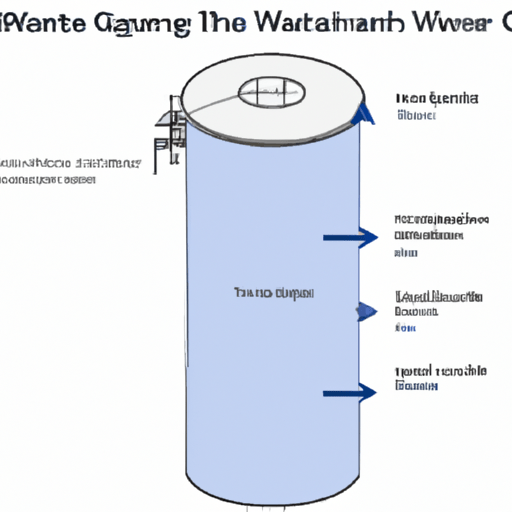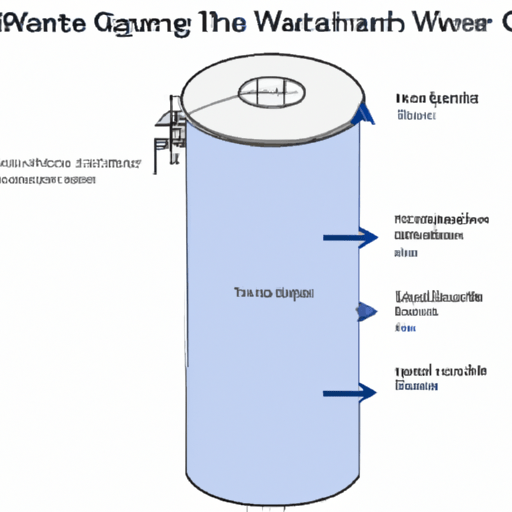So, you’re interested in off grid living? That’s awesome! There’s something so freeing about being self-sufficient and not reliant on traditional utilities. Well, one of the key things you’ll need to consider for your off grid setup is a gravity-fed water system. And a major factor in making sure that system works efficiently is determining the optimal height for your water tank.
Now, you might be wondering, how high should a gravity-fed water tank be? It’s a good question, and one that has a simple answer: it depends. The height of your water tank will ultimately depend on various factors such as the layout of your property, the slope of the land, and the amount of water pressure you require.
In our upcoming article, we’ll dive into the nitty-gritty details of determining the optimal height for a gravity-fed water tank. We’ll cover everything from the basics of gravity-fed systems to the different factors that can influence the ideal tank height. By the end of the article, you’ll have a clear understanding of how to calculate and set up your gravity-fed water system for maximum efficiency. Stay tuned!

The Optimal Height of a Gravity-Fed Water Tank
Living off the grid comes with its own challenges, and one of the most essential requirements is a reliable water supply. In situations where access to a centralized water system is not possible, gravity-fed water tanks can be a great solution. These tanks rely on the force of gravity to provide water pressure, eliminating the need for complex pumps or electricity. But how do you ensure the optimal height for your gravity-fed water tank? Let’s delve into this topic and explore the factors to consider when determining the height that will guarantee efficiency and reliability.
What is a gravity-fed water tank?
A gravity-fed water tank is a storage container that is positioned at an elevated location, allowing gravity to create the necessary water pressure for optimal functionality. These tanks are commonly used in off-grid living situations, such as rural homes, cottages, or even in emergency situations where a reliable water supply is a must.
Components of a gravity-fed water tank
To better understand how the height of a gravity-fed water tank impacts its functionality, it is important to be aware of its key components. A gravity-fed water tank is made up of the following:
- Tank: The tank itself acts as the storage container for the water. It comes in various sizes to accommodate different water volumes and requirements.
- Inlet valve: The inlet valve is responsible for regulating the flow of water into the tank. It ensures that the tank does not overflow.
- Outlet valve: The outlet valve controls the flow of water out of the tank and into the plumbing system.
- Overflow pipe: The overflow pipe serves as a safety mechanism to prevent the tank from overflowing. It diverts excess water away from the tank, protecting it from damage.
Now that we have a basic understanding of what a gravity-fed water tank is, let’s explore the importance of the height of the tank in relation to its efficiency and water pressure.
Efficiency and water pressure
The height of a gravity-fed water tank plays a crucial role in determining its efficiency and water pressure. The greater the height, the more potential energy is available and the higher the water pressure will be. This increased water pressure ensures a steady and reliable flow of water throughout your plumbing system.
Water flow rate
In addition to water pressure, the height of a gravity-fed water tank also impacts the water flow rate. The flow rate refers to the volume of water that can be delivered within a specific amount of time. A higher tank height typically results in a faster flow rate, allowing for a greater amount of water to be delivered to your point of use.
Factors to consider when determining the optimal height
Determining the optimal height for your gravity-fed water tank requires careful consideration of several factors. These factors include:
Elevation of the intended point of use
First and foremost, you need to determine the elevation of the point where you plan to use the water. The height difference between the tank and this point will directly impact the water pressure. The greater the height difference, the higher the water pressure will be.
Available water source
Before deciding on the height of your tank, you must identify the available water source. The source could be a natural spring, a well, or even rainwater collected from a rooftop. Take into account the elevation of the water source and consider any inclines or declines the water will encounter as it flows from the source to the tank.
Volume of water needed
You also need to determine the volume of water you require on a daily basis. Factors such as the number of occupants in your household, daily water usage, and the types of appliances or fixtures you have will all contribute to this calculation. The volume of water needed will help you determine the size of the tank and subsequently, the required height.
Calculating the optimal height
Calculating the optimal height for your gravity-fed water tank involves several considerations. Here’s a step-by-step guide to help you through the process:
Determining desired water pressure
First, determine the desired water pressure you want for your point of use. This can vary depending on the specific needs of your household, but generally, a minimum water pressure of 20 psi (pounds per square inch) is recommended for most homes. However, some appliances or fixtures may require higher pressure, so always check their specifications.
Consideration of pipe diameter and length
Next, consider the diameter and length of the pipes that will be connected to the tank. Smaller diameter pipes or longer pipe lengths can result in greater friction, which can impact water pressure. Ensure that the pipes are sized appropriately and that their length is minimized as much as possible to reduce frictional losses.
Frictional losses
Frictional losses occur when water flows through the pipes and encounters resistance, resulting in a decrease in water pressure. These losses can be calculated using various formulas and take into account factors such as pipe material, diameter, length, and flow rate. Minimizing frictional losses is vital to maintaining optimal water pressure.
Potential challenges and their solutions
Despite careful calculations and considerations, some challenges may still arise when determining the optimal height of your gravity-fed water tank. Here are a few potential challenges and their solutions:
Insufficient water pressure
If you find that the water pressure at your point of use is insufficient, there are a few possible solutions. You could consider increasing the height of your tank, installing a booster pump to increase pressure, or reconfiguring your plumbing system to reduce frictional losses.
Limited available height
Not everyone has the luxury of a high elevation or a hilltop to position their gravity-fed water tank. In such cases, you may consider constructing an elevated platform or even burying the tank partially underground to create the necessary height differential for optimal water pressure.
Minimizing frictional losses
To minimize frictional losses, ensure that your pipes are properly sized, have smooth surfaces, and are adequately insulated against temperature changes. Additionally, regular maintenance and inspections are crucial to identify and address any blockages or damage that may result in reduced water pressure.
Construction and design considerations
When constructing and designing your gravity-fed water tank system, it’s important to consider the following:
Choosing the right tank size
The size of your tank should be based on your water usage needs and available space. Consider factors such as the number of occupants, daily water requirements, and any potential future expansion. It is typically advisable to choose a tank with a larger capacity to ensure a reliable supply of water.
Ensuring stability and support
The placement of your tank should prioritize stability and support to prevent any accidents or damage. Ensure that the tank is positioned on a solid and level foundation, and that it is securely anchored or supported to withstand any external forces such as winds or seismic activity.
Proper plumbing and connections
Proper plumbing and connections are essential for the efficient operation of your gravity-fed water tank system. Use high-quality pipes, fittings, and valves to minimize leaks, ensure proper water flow, and reduce frictional losses. Regularly inspect the system for any signs of leaks or damage and address them promptly.
Regulations and safety standards
When installing a gravity-fed water tank, it is important to comply with local building codes and regulations. Obtain the necessary permits and ensure that your system meets all safety standards to prevent any potential hazards or contamination. Regular maintenance and inspections are also important to ensure the ongoing safety and reliability of your system.
Alternative options for water supply
While gravity-fed water tanks can provide a reliable and cost-effective solution for off-grid living, there are alternative options to consider:
Pump systems
If the elevation of your water source or point of use is not suitable for a gravity-fed system, you may need to consider a pump system. Pump systems use mechanical force to create water pressure and can be a viable solution in situations where gravity-fed tanks are not feasible.
Rainwater harvesting
Rainwater harvesting is a sustainable and environmentally-friendly alternative to traditional water sources. By collecting rainwater from rooftops and storing it in tanks, you can reduce your reliance on other water sources. Rainwater can be used for various purposes, including irrigation, laundry, and even drinking water with the proper filtration systems in place.
Water delivery services
In some cases, relying on water delivery services may be the best option. These services involve regular deliveries of water to your property, eliminating the need to install and maintain your own water supply system. While this option may come with additional costs, it guarantees a consistent supply of water without any of the upfront installation or maintenance requirements.
Cost considerations
When considering the optimal height of your gravity-fed water tank, it’s important to take into account the various costs involved:
Initial setup and installation
The initial setup and installation costs of a gravity-fed water tank system can vary depending on factors such as the tank size, plumbing requirements, and any necessary infrastructure modifications. It is advisable to consult with professionals to obtain accurate cost estimates and ensure a proper installation.
Maintenance and repairs
Regular maintenance and repairs are essential to keep your gravity-fed water tank system running smoothly. Consider the cost of routine inspections, cleaning, and any necessary repairs. It is important to factor these ongoing costs into your budget to ensure the long-term sustainability of your system.
Long-term savings
While there may be upfront costs associated with the installation and maintenance of a gravity-fed water tank system, the long-term savings can outweigh these expenses. By relying on gravity and natural forces, you can reduce or eliminate the need for electricity or fuel to power pumps. This can result in significant savings over time and contribute to a more sustainable and self-sufficient lifestyle.
Conclusion
Determining the optimal height of a gravity-fed water tank is crucial for its functionality and efficiency. By carefully evaluating factors such as elevation, available water sources, volume needs, and other considerations, you can ensure optimal performance, reliable water supply, and cost-effective solutions for off-grid living. Remember to always comply with building codes, safety standards, and local regulations to ensure the safety and sustainability of your water supply system.




